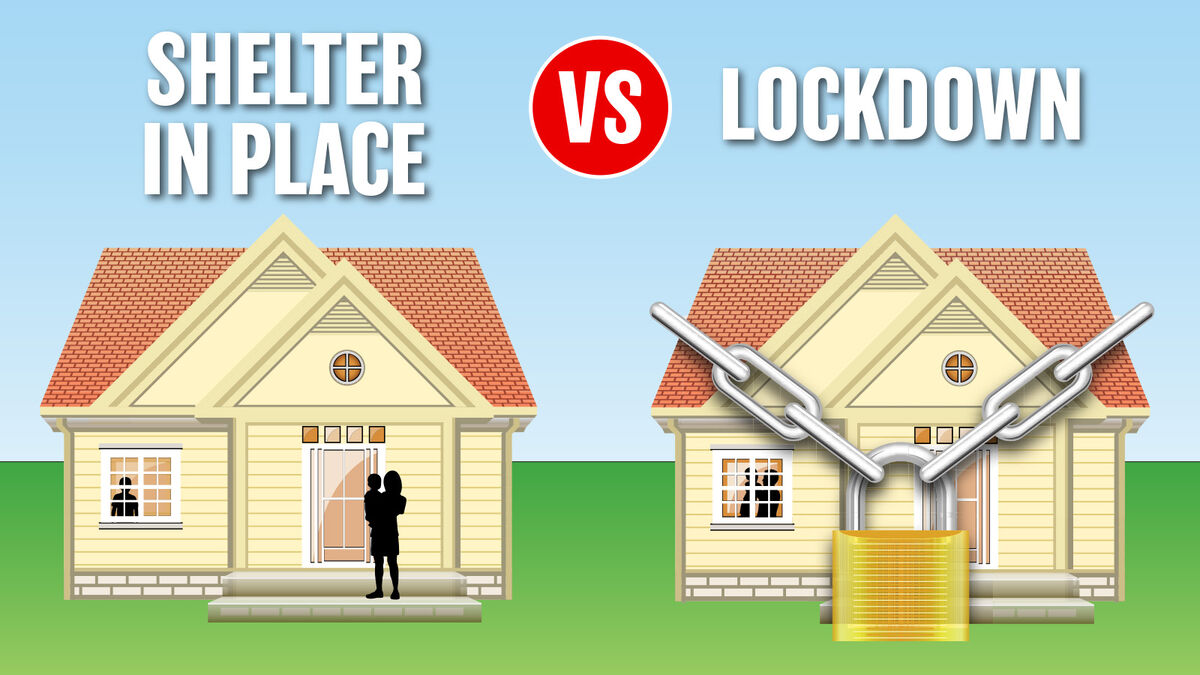
Understanding how to use “shelter in place” vs. “lockdown” involves getting a sense of the key differences between these terms and the way they may affect a population. You may notice that some media sources use “lockdown” and “shelter in place” interchangeably, but these are very different terms. While both terms refer to restricting movement of citizens due to a threat, the distinction involves the effects of the restrictions.
Meaning of Shelter in Place vs. Lockdown
In the case of both “shelter in place” and “lockdown,” the actual restrictions imposed will depend on the threat faced by the citizenry. Understanding the general meanings can help in a crisis.
“Shelter in Place” Meaning and Examples
Countries, states, cities, and towns can all impose a “shelter in place” order to keep citizens safe and off the streets in the event of a threat. The specific reason for sheltering in place will vary depending on the crisis:
- For instance, in the case of the Boston Marathon bombings in 2013, the city asked people to shelter in place to stay out of the line of fire and away from danger.
- Many people were also asked to shelter in place as part of the coronavirus COVID-19 pandemic in 2020 to prevent the spread of contagious illness from person to person.
“Shelter in place” isn’t a legal term, and its exact meaning will depend on the specific threat. For instance, in an environmental threat like a tornado, sheltering in place may mean going to the basement. In a pandemic, it may mean staying home to avoid spreading disease. These are a few of the behaviors covered in a shelter in place order:
- Seek cover from a storm or environmental threat
- Close and lock doors and windows
- Stay home and avoid unnecessary trips out in a pandemic
- Stay inside, even if you aren’t at home
“Lockdown” Meaning and Examples
A lockdown is stricter than sheltering in place. In general, it prohibits people from leaving an area during a crisis, although the specifics vary with the situation.
- In 2001, there was a lockdown of US air space that grounded all civilian planes after 9/11.
- During the coronavirus COVID-19 pandemic of 2020, many countries instituted lockdowns to prevent people from entering or exiting through borders.
A “lockdown” may be legally enforced, but that can vary from one state to another or among countries. A lockdown for an active shooter at a public place can look very different from a lockdown for a pandemic. These are a few of the behaviors that a lockdown could involve:
- Locking all doors and windows to prevent an intruder
- Turning off lights and silencing phones to confuse an intruder
- Staying within a building until told otherwise
- Staying within the borders of a town, city, or state until told otherwise
Differences Between Lockdowns and Shelter-in-Place Orders
While these two terms are used interchangeably in some situations, they do have different meanings. The confusion comes from the way the specific effects can vary in different situations. However, there are a few key differences that are there, no matter what is causing the restrictions.
Is It Legally Enforced?
Since a shelter-in-place order is not a legal term, it may not be legally enforceable. A lockdown can be, depending on the jurisdiction. Whether that means you may get arrested for violating or just receive a fine, it is an important distinction.
What Are the Effects?
The effects of a lockdown are different than those of a shelter-in-place order. When ordered to shelter in place, people must stay in or near home and reduce exposure to the outside world. In a shelter-in-place situation, individuals may be permitted outside for certain activities.
In a lockdown, they need to stay home and sometimes even secure the perimeter of their house or apartment. There are usually fewer exceptions to when they may be able to leave.
What Kind of Threat Is It Preventing?
In general, a lockdown is designed to prevent an imminent threat - something that is happening now or will happen very soon. A shelter-in-place order is designed to reduce the risk of a threat that is imminent or may be approaching at a slower rate. For instance, a lockdown protects people when there is an active shooter. A shelter-in-place order protects people when a storm is approaching.
Distinctions Matter
Whether you’re reading the news or writing an essay, the subtle distinctions between terms like “lockdown” and “shelter in place” matter. Understanding the differences between these words will help you express yourself more clearly.